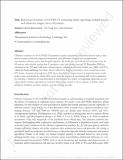Behavioral dynamics of COVID‐19: estimating underreporting, multiple waves, and adherence fatigue across 92 nations
Author(s)
Rahmandad, Hazhir; Lim, Tse Yang; Sterman, John
DownloadSubmitted version (6.346Mb)
Open Access Policy
Open Access Policy
Creative Commons Attribution-Noncommercial-Share Alike
Terms of use
Metadata
Show full item recordAbstract
Effective responses to the COVID-19 pandemic require integrating behavioral factors such as risk-driven contact reduction, improved treatment, and adherence fatigue with asymptomatic transmission, disease acuity, and hospital capacity. We build one such model and estimate it for all 92 nations with reliable testing data. Cumulative cases and deaths through 22 December 2020 are estimated to be 7.03 and 1.44 times official reports, yielding an infection fatality rate (IFR) of 0.51 percent, which has been declining over time. Absent adherence fatigue, cumulative cases would have been 47 percent lower. Scenarios through June 2021 show that modest improvement in responsiveness could reduce cases and deaths by about 14 percent, more than the impact of vaccinating half of the population by that date. Variations in responsiveness to risk explain two orders of magnitude difference in per-capita deaths despite reproduction numbers fluctuating around one across nations. A public online simulator facilitates scenario analysis over the coming months.
Date issued
2021-01Department
Sloan School of ManagementJournal
System Dynamics Review
Publisher
Wiley
Citation
Rahmandad, Hazhir et al. "Behavioral dynamics of COVID‐19: estimating underreporting, multiple waves, and adherence fatigue across 92 nations." System Dynamics Review 37, 1 (January 2021): 5-31. © 2021 System Dynamics Society
Version: Original manuscript
ISSN
0883-7066
1099-1727